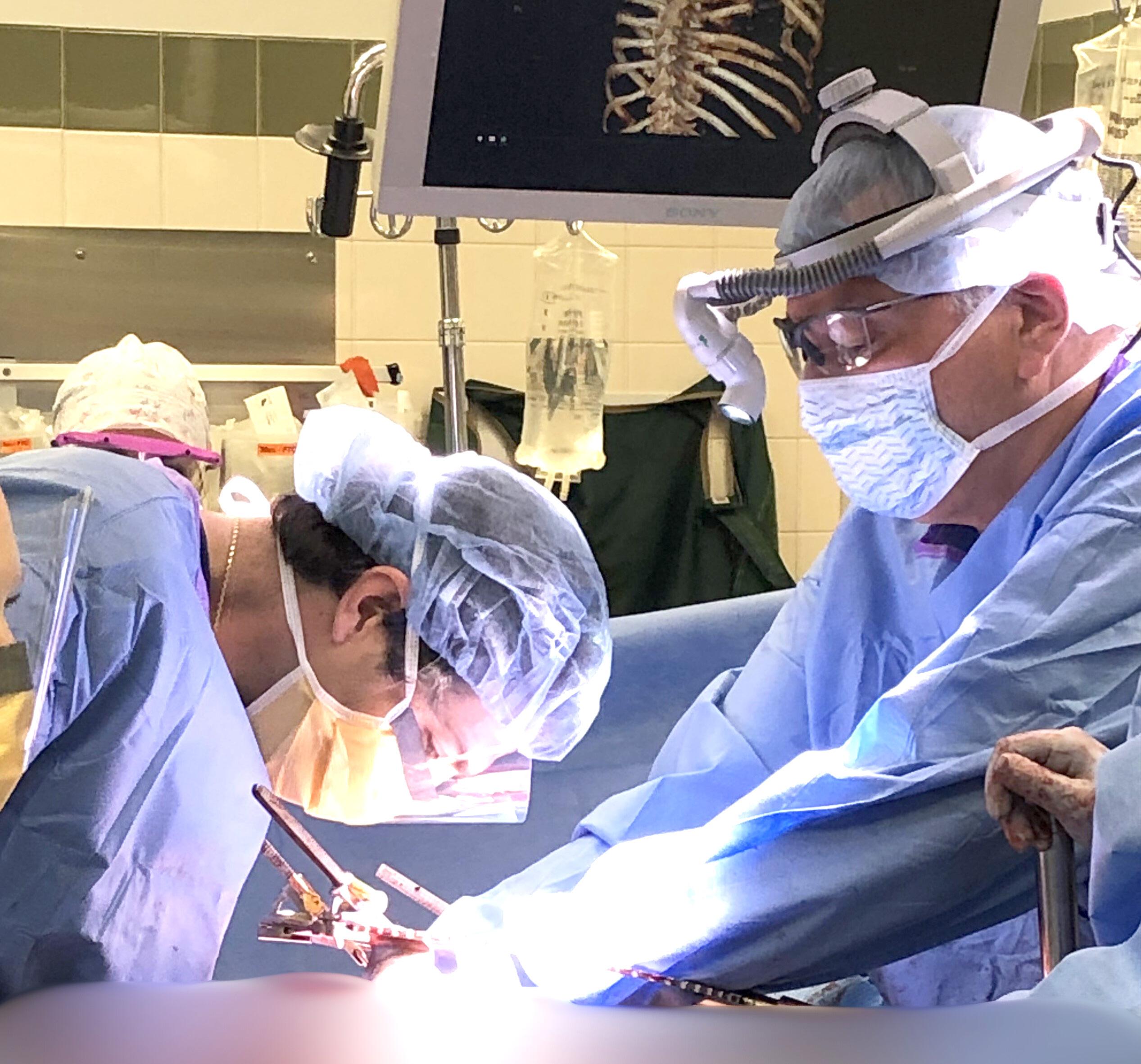
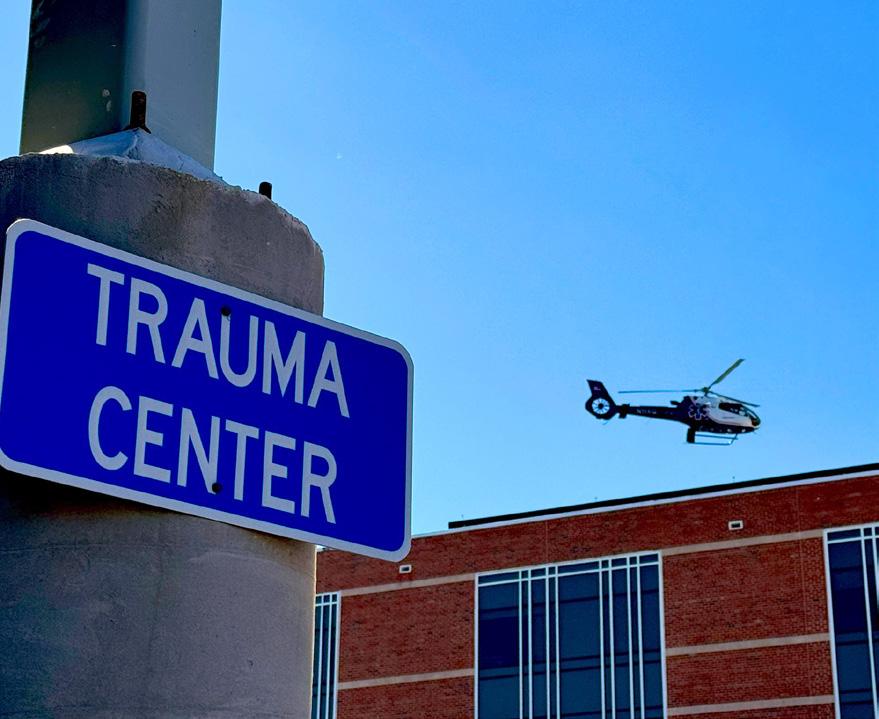
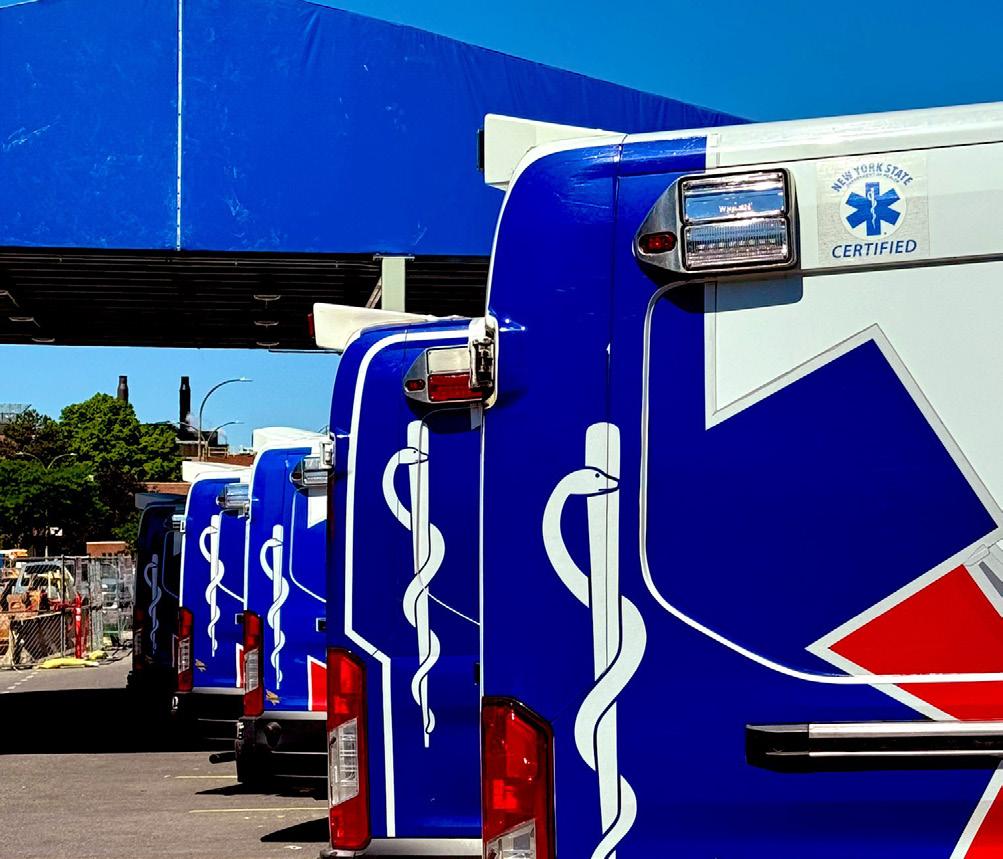
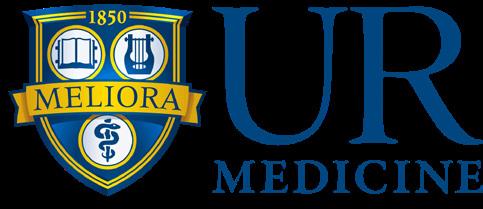

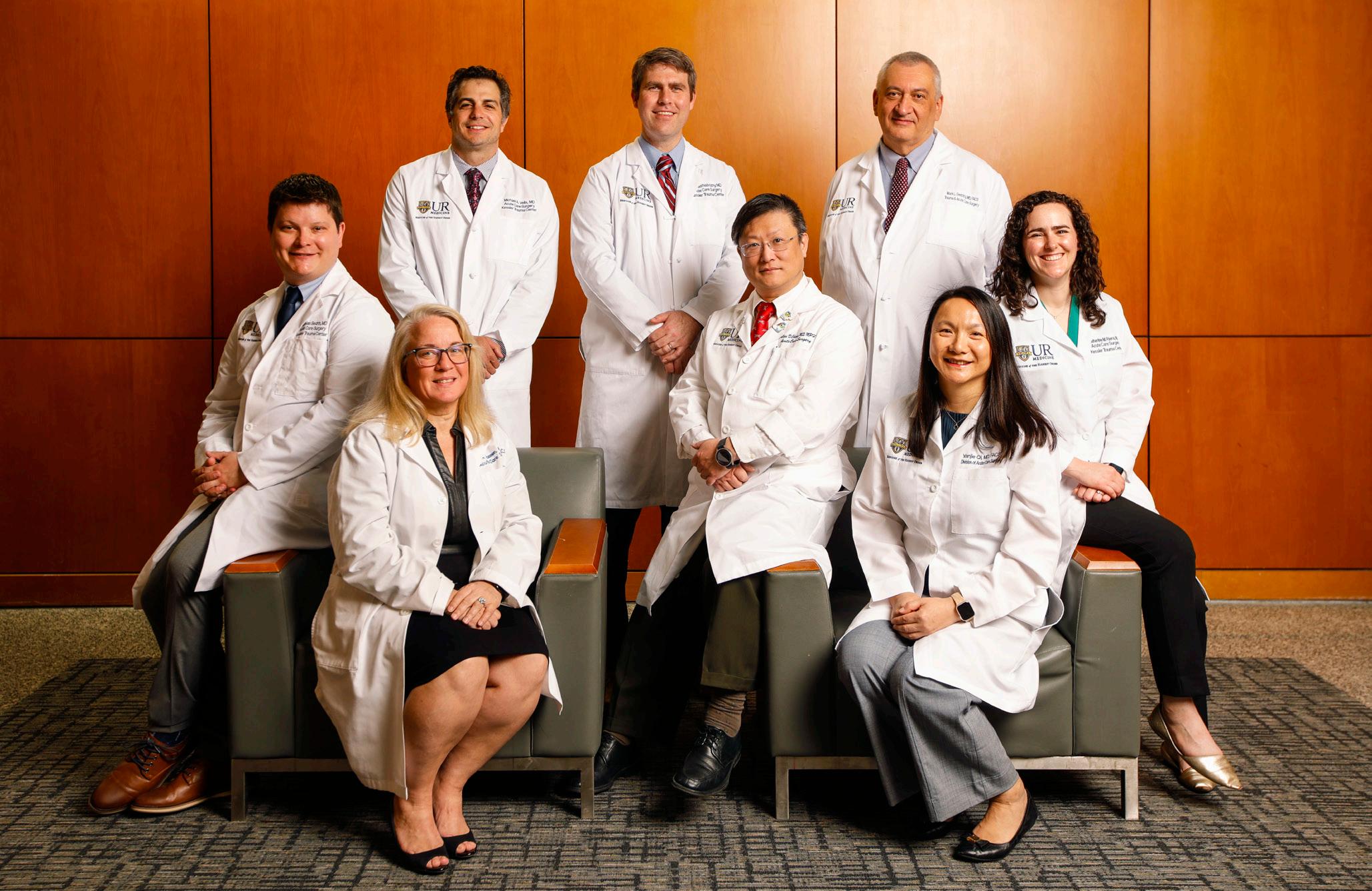







The Kessler Trauma Center, located at Strong Memorial Hospital, is proud to provide state-ofthe-art injury care to the citizens of the Finger Lakes Region of Western New York. Verified by the American College of Surgeons and designated by the New York State Department of Health as a Level 1 Trauma Center, the hospital serves a population of over 1.5 million residents spanning thirteen counties. Strong Memorial Hospital is a nine hundred bed tertiary care facility that admits over 2,500 injured patients each year. The Kessler Trauma Center is staffed around the clock by fellowship-trained, board-certified trauma surgeons
and surgical intensivists supported by orthopedic, neurosurgery, vascular and plastic surgeons. The facility boasts a specialized Burn-Trauma Intensive Care Unit (BTICU), multiple operating rooms, modern imaging technology, a full-service blood bank, an in-house Commission on Accreditation of Rehabilitation Facilities (CARF) accredited rehabilitation unit and a highly-experienced team of nurses, technicians and other specialized providers. The focus on clinical excellence is supported by the Kessler Trauma Center’s commitment to community outreach, education, injury prevention and research.
Thank you for your ongoing support of the University of Rochester’s Level 1 Kessler Trauma Center. We are proud of our program and privileged to be able to share our activities over the last year with you.

While we have noted decreases in firearm injury over the last year, trauma volumes overall have been increasing without the usual winter lull we have seen in years past. Overall volume of injured patients has increased by 16 percent over the last five years and 8 percent between 2023 and 2024. Admissions specifically to the trauma service have increased 41 percent over the last five years. The clinical care that our Trauma Program and multidisciplinary colleagues continue to provide is exceptional. Our overall survival rate remains high at over 95 percent, and we continue to perform among the top centers in the country with respect to patient outcomes. Beyond the hospital, our program continues to advance trauma care through education, research, and outreach. I would like to highlight a few of these accomplishments and initiatives below.

• We continue to advocate for blood product availability on ground ambulances in New York State, supporting recently passed legislation. Our team is actively involved at the regional and state level to determine how to best operationalize this practice and ensure pre-hospital blood availability throughout the region.
• Our trauma center was recently awarded an American Trauma Society grant for “Bingocize”, a program aimed at decreasing fall risk in the elderly. This initiative was led by our new injury prevention and outreach coordinator, Sarah Gorman, R.N.
• Our program recently purchased and integrated new registry software led by our lead registrar, Margaret Vercruysse, L.P.N. This upgrade will allow for better data capture with expanded research and performance improvement
capabilities, including real time monitoring of patient outcomes and complications.
• We are making significant progress on the construction of our new emergency department tower. The Trauma Program participated in the design of the trauma resuscitation bays from the ground up, and we look forward to working in this new state-of-the-art space in the next few years.

• We continue to update and develop new clinical practice management guidelines to ensure that we are providing the most current care possible. Multiple faculty members are also involved in the development of practice management guidelines on the national level.
• Nicholas Bedrin, M.D., our new Advanced Trauma Life Support (ATLS®) director, continues to lead a robust ATLS® program at our facility and has helped outside institutions get ATLS® programs up and running to ensure this important course is available throughout the region.
• Our faculty are involved in the development of new versions of the Rural Trauma Team Development Course (RTTDC®) and Stop the Bleed® curriculum, courses that are taught throughout the world to improve trauma care delivery.

• Pediatric readiness and the development of Regional Medical Operations Command Centers (RMOCC) are priorities of the American College of Surgeons Committee on Trauma. Our faculty and staff are actively involved in pushing these initiatives locally, at the state level, and nationally.
• The program continues to advocate for legislation to improve the care of injured patients. Multiple faculty members recently participated in the American College of Surgeons Leadership and Advocacy Summit in Washington, D.C., where they met with lawmakers from New York State to discuss support and funding for important trauma programs related to injury prevention and access to quality trauma care.
• We are currently involved in five societysponsored multi-institutional trials, multiple ongoing local research projects, and the development of three society-sponsored practice management guidelines. The Kessler
Trauma Center is the lead institution in the Upstate Acute Care Surgery Research Collaborative, a group of Upstate New York trauma centers that meets on a regular basis to facilitate multicenter research projects and discuss best practices. We are working to expand this program to involve centers throughout New York and New Jersey. Our trauma residents and program staff have won numerous research awards through presentations at national meetings over the past year.
It is a privilege to continue to serve as Trauma Medical Director at the University of Rochester.
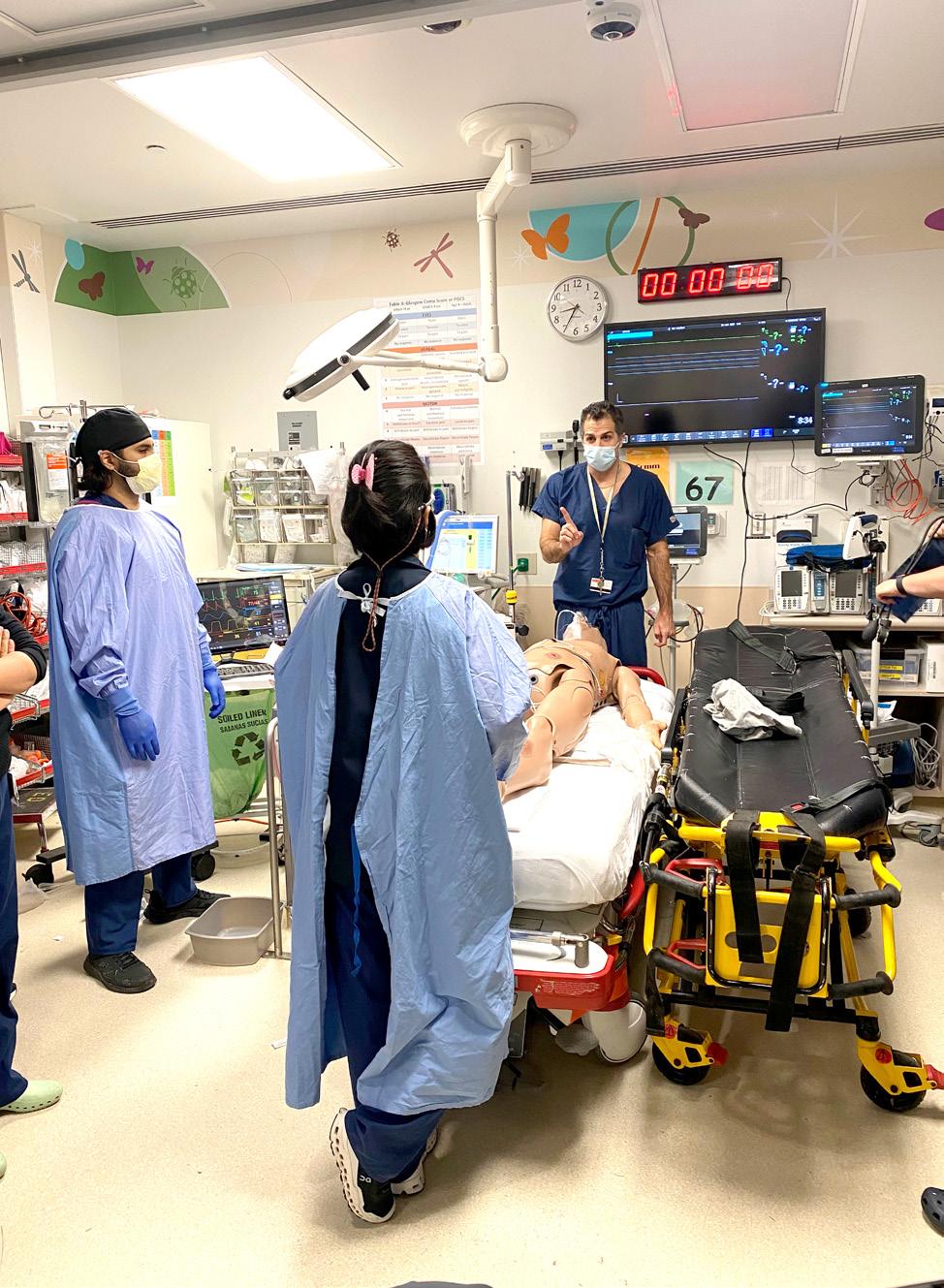
Our group looks forward to sharing our program accomplishments with you, specifically highlighting some of the individuals who make our Trauma Program special. Please do not hesitate to reach out to me or any of our program staff if you have any questions about the program or are interested in any of our outreach or educational offerings.

Michael A. Vella, M.D., M.B.A., F.A.C.S. Trauma Medical Director
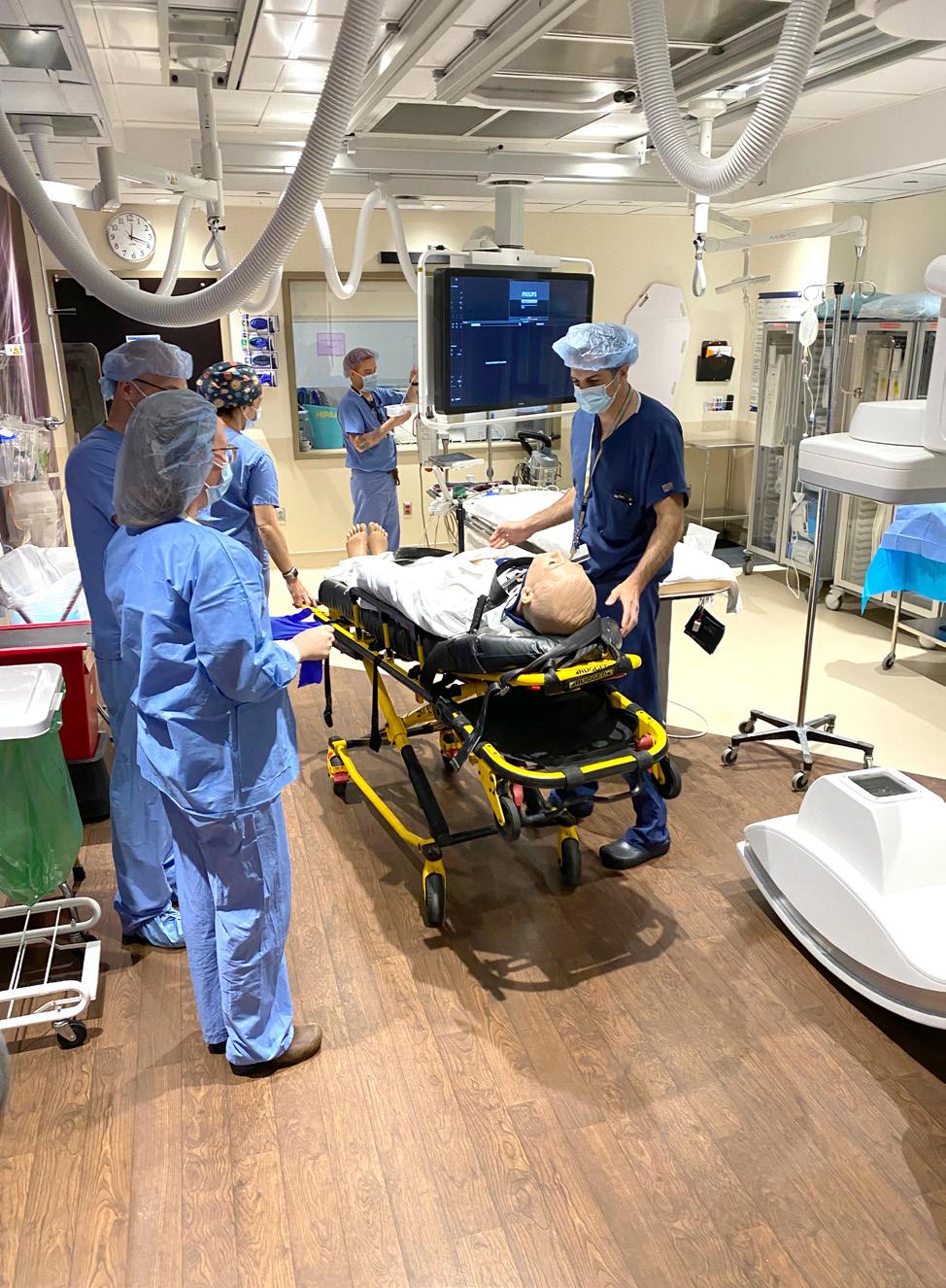
Surgeons:





Mark Gestring , M.D., F.A.C.S., Professor of Surgery, Emergency Medicine and Pediatrics; Chief, Division of Acute Care Surgery
Nicholas Bedrin, M.D., Assistant Professor of Surgery and Pediatrics; Director of Simulation and Trauma Education
Julius Cheng, M.D., M.P.H., F.A.C.S., Professor of Surgery and Pediatrics; Professor of Clinical Nursing, School of Nursing
Yanjie Qi, M.D., F.A.C.S., Associate Professor of Surgery and Pediatrics; General Surgery Residency Program Director
Michael Nabozny, M.D., F.A.C.S., Assistant Professor of Surgery and Pediatrics

Kate Dellonte, R.N., M.B.A., B.S.N.; Michael Vella, M.D., M.B.A., F.A.C.S.




Katherine Riera, M.D., Assistant Professor of Surgery and Pediatrics; Associate Trauma Medical Director
Michael Rotondo, M.D., F.A.C.S., Professor of Surgery; Associate Vice President for Administration; Chief Executive Officer; Vice Dean for Clinical Affairs
Nicole Stassen, M.D., F.A.C.S., Professor of Surgery and Pediatrics; Medical Director of the Kessler Family Burn/Trauma ICU; Surgical Critical Care Fellowship Director
Michael Vella, M.D., M.B.A., F.A.C.S., Associate Professor of Surgery and Pediatrics; Trauma Medical Director
Trauma Program Team:
Kate Dellonte, R.N., M.B.A., B.S.N., Trauma Program Manager
Sarah Gorman, R.N., B.S.N., E.M.T., Injury Prevention and Outreach Coordinator
Rachael Podsiadlo, R.N., B.S.N., Performance Improvement Coordinator
Becky Chatt, R.N., M.S., Trauma Program Educator
Brooke Streiff, M.H.A., Trauma Program Administrator
Tamara Englert, B.A.S., Trauma Program Administrative Assistant
Trauma Registrars:
Margaret Vercruysse, L.P.N., B.S., C.S.T.R., C.A.I.S.S.
Lead Trauma Registrar
Jill Bush, L.P.N.
Stacie Gell, B.S., C.S.T.R., C.A.I.S.S.
Trauma Advanced Practice Providers:
Jacob Privitera, P.A., Lead Trauma APP
Nichole Coleman, N.P.
Leah Green, N.P.
Elizabeth Lawatsch, P.A.
Katherine Perry, L.P.N.
Abby Rothwell, B.S., B.A.
Andrea Masiello, N.P.
Kelsey Potter, N.P.
Caitlin Randall, N.P.
Zachary Woughter, P.A.
Burn Trauma Intensive Care Unit Advanced Practice Providers:
Jonathan Krotz, N.P., Lead BTICU APP
Madisonne Delmege, N.P.
Lauren Montreuil, P.A.
Brent LaRiccia, P.A.
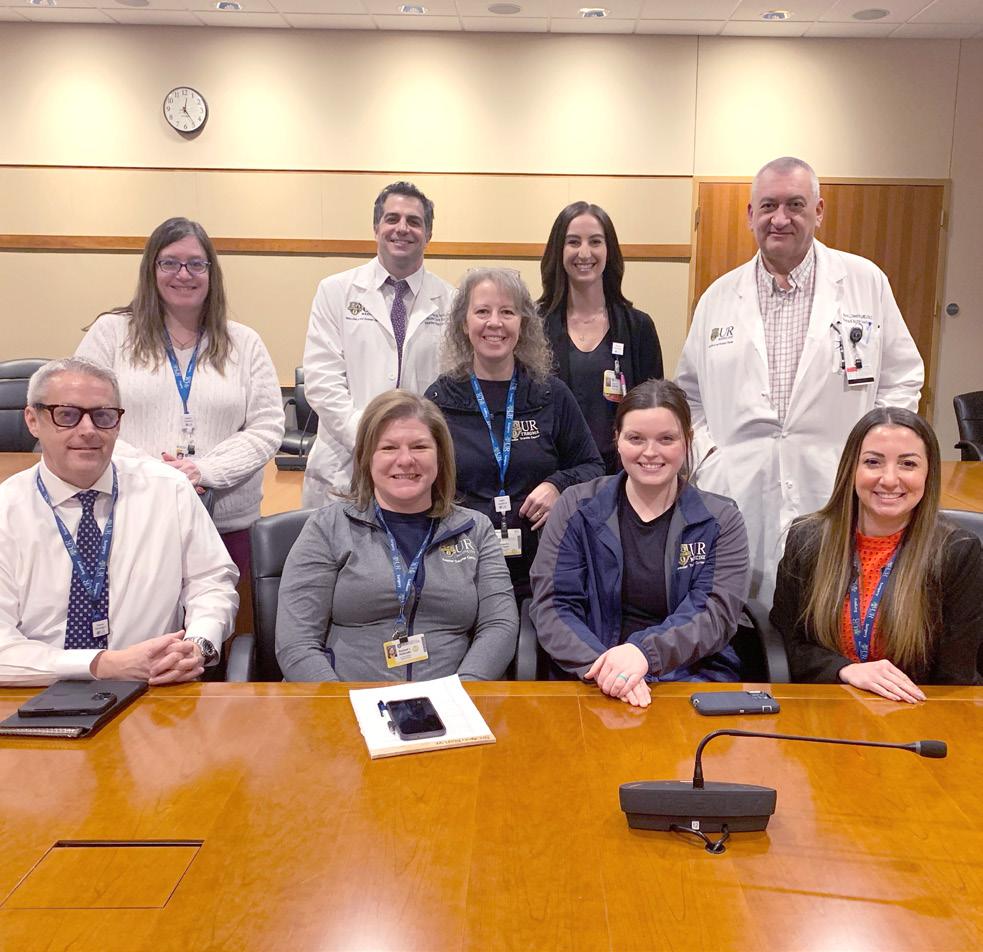
Trauma Program Team:
Tamara Englert, B.A.S.; Michael Vella, M.D.; Kate Dellonte, R.N.; Mark Gestring, M.D.; Adam Oplinger, R.N.; Rachael Podsiadlo,R.N.; Margaret Vercruysse, L.P.N.; Riley Youells, EMT-P.; Becky Chatt, R.N.
Lisa Judge, N.P.
Kylie Terwilliger, P.A.
Christian Jennette, P.A.
Specialty Liaisons:
Derek Wakeman, M.D., Pediatric Trauma Medical Director
Neil Blumberg, M.D., Blood Bank
David Grimes, D.O., Anesthesia
Catherine Humphrey, M.D., M.B.A., Orthopedic Surgery
Kaylee Maynard, PharmD, Pharmacy
Kristina Meyers, M.D., Hospital Medicine
Andrea Miglani, M.D., Emergency Medicine
Heather Ma, M.D., Physical Medicine and Rehabilitation
Daniel O’Connor, M.D., Radiology
David Paul, M.D., Neurosurgery
Debra Roberts, M.D., Ph.D., Neuro Medicine ICU
G. Edward Vates, M.D., Neurosurgery



Regular trauma-related continuing medical education efforts ensure that all providers remain current with the latest advances in trauma care. The Kessler Trauma Center at Strong Memorial Hospital is committed to teaching staff and our community partners how to manage critically injured patients.
Advanced Trauma Life Support (ATLS®) was developed by the American College of Surgeons to provide a systematic, concise approach to trauma care that is applicable to any hospital setting. ATLS® focuses primarily on rapid assessment and initial stabilization and provides the cornerstone of management of the most critically injured patients. The Kessler Trauma Center offers this two-day course eight times per year, including an instructor course, hosting students from across the U.S. and beyond.
Advanced Trauma Care for Nurses (ATCN®) is an advanced course designed for the nurse interested in increasing his/her knowledge in the management of the injured patient. Benefits of ATCN® training include an educational, team building, collaborative, and synchronized approach to trauma care. The Kessler Trauma Center continues to increase the number of yearly offerings due to high demand and success with the course. In 2024, the Kessler Trauma Center became an ATCN® sister site with ATCN® Italy to mentor them by sharing best practices, assist with building their programs, and improve nursing interventions.
This hands-on educational offering occurs at least once a month and provides an opportunity for all learners (residents, nurses, advanced practice providers, patient care technicians, respiratory therapists, etc.) to gain experience with trauma-specific equipment, procedural set-up, and procedural skills. Taught by experienced surgeons and Trauma Program staff, the course includes training on intra-osseous and complex vascular access, application of tourniquets and pelvic binders, the use of Resuscitation Balloon Occlusion of the Aorta (REBOA), ultrasound, chest tube insertion, and emergency department operative procedures, to name a few. This course is required for all surgical/trauma trainees at least once a year.
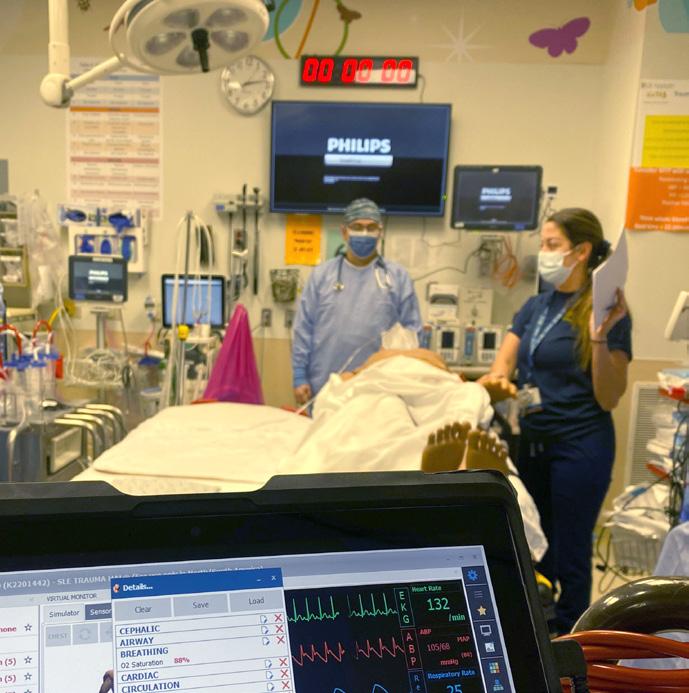
The mobile skills lab is an extension of the trauma skills lab, providing a similar experience for our


regional hospital and EMS partners. Our Mobile Education Unit and state-of-the-art trauma simulator allowing us to teach trauma-specific skills outside of our facility to improve the overall care of injured patients in our larger region. We continue to increase our mobile skills offerings to various EMS, law enforcement, and fire departments across the region, many of which are taught on nights and weekends due to the agency schedules and availability. Our Trauma Nurse Educator, Becky Chatt, R.N. presented a poster on our mobile skills lab at the Society of Trauma Nurses Annual Conference in Orlando,
Florida titled “Effectiveness and Reception of Mobile Simulation-Based Trauma Education for Pre-Hospital Providers”. This presentation garnered much interest from many trauma centers across the nation and we are now helping to create mobile skills programs at these centers.
Trauma simulation provides an opportunity to hone technical and team skills in a controlled and safe environment. Utilizing the most advanced trauma simulators, we host monthly simulations in the adult and pediatric emergency departments as well as the Trauma ICU. Simulated scenarios are based on actual trauma resuscitations in which we identified potential opportunities for improvement. Over the last year, simulation scenarios have expanded to include mass casualty
incidents, patient drop-offs by private vehicle, and patient progression from the ED to the Trauma ICU. Furthermore, one of our newest Trauma Faculty members with simulation program expertise has been appointed to co-lead, alongside our Trauma Service Nurse Educator, efforts aimed at continuing to enhance and expand our simulation program.
The Rural Trauma Team Development Course (RTTDC®) was developed by the American College of Surgeons and is intended to improve the quality of care in rural settings by helping non-trauma centers recognize critically injured patients and offering them tools for stabilizing these patients for transfer to a trauma center. This course is typically
offered four times in the spring and four times in the fall, or as requested, at facilities in rural communities. In 2024, in addition to teaching the course throughout our region, we hosted a joint course with the Upstate Medical University Trauma Program from Syracuse, New York for the Cayuga Medical Center and Shuyler Hospital medical teams


Disaster Management and Emergency Preparedness (DMEP®) teaches planning methods, preparedness, and medical management of trauma patients in mass casualty disaster situations.
The Trauma Education Conference is a homegrown program offering monthly trauma education on topics ranging from wound care to physical therapy to clinical management of specific injuries. Instructors include local experts as well as those on the national stage. This virtual course is also offered to our regional partners.
The Division houses a long standing ACGME-accredited one-year surgical critical care fellowship which provides significant flexibility for trainees to tailor their education to their unique goals. Fellows rotate through our busy burn trauma, surgical, and neuromedicine intensive care units and participate in the acute management and operative care of injured patients. We are proud to train the next generation of surgical critical care leaders.


A robust community outreach and injury prevention agenda has seen staff from the Kessler Trauma Center interact with thousands of individuals throughout Rochester, Monroe County and the Finger Lakes Region. Our injury prevention and outreach programs are data-driven, prioritizing injury trends identified using our center’s unique patient data registry. In 2024, we provided over forty Stop the Bleed® classes and attended numerous regional community events. A few highlights include:
Developed by the American College of Surgeons to provide hemorrhage control training for members of the public, Stop the Bleed® has been one of our most popular offerings. As one of the largest training centers in the Northeast, our audience includes small groups of less than ten to large groups of three hundred and everything in between. We partner with Stop the Bleed®
instructors from many different first responder organizations in our area to deliver this lifesaving training. On National Stop the Bleed Day, we


Adam Oplinger, R.N. alongside other members of community agencies on wear orange weekend to raise awareness and work together to end gun violence
hosted drop-in training in the main lobby of Strong Memorial Hospital. We had great success with this event, educating and training over one hundred people.
The Trauma Program is embedded into the RYVP Program, which works to identify at-risk youth with a goal of eliminating recidivism by providing meaningful options to kids and their families. Based at the Kessler Trauma Center, this group relies on relationships developed with local and regional agencies of all types including law enforcement, hospital, school district and community support groups. This program is unique in several ways and efforts to replicate it in surrounding areas are ongoing. The Rochester Youth Violence Partnership is now part of the National Network of Hospitalbased Violence Interventions Programs (NNHVIP).
The Responsible Gun Ownership Program is a collaboration between the Kessler Trauma Center and the Monroe County Sheriff’s Office focused
on educating legal gun owners about safe and responsible firearm practices. This unique program delivers community outreach in multiple settings, ranging from classroom-style presentations to open table setups at public events. Since its inception, the program has engaged a diverse audience across multiple venues, including outdoor festivals, farmers markets, gun stores, and even an airport.
Key Program Components:
• Education on local gun laws
• Safe gun storage and handling practices
• Firearm injury prevention strategies
• Individualized risk assessments
• Connections to relevant resources
• Distribution of gun locks
The Trauma Program collaborates directly with a representative from the Monroe County Sheriff’s Office to host these events. Each event facilitates

Responsible Gun Ownership community event with Adam Oplinger, R.N., Nicole Stassen, M.D., and members of the Monroe County Sheriff’s Office
meaningful interactions between content experts and interested gun owners. The team conducted numerous events in 2024, each lasting three to six hours, resulting in hundreds of individual conversations promoting responsible gun ownership. Our proactive approach and response to community requests has led to an increasing demand for our presence. Feedback from participants and community partners has been overwhelmingly positive and the program continues to grow.
The Trauma Surgery service was thrilled to participate in the Teens Against Violence Alliance (TAVA) program. This program was developed in partnership with EnCompass Future Ready Program, Black Men Achieve Program, URMC Department of Surgery, and the city of Rochester and it allows teen participants to engage in nearly two hundred hours of educational, mentoring, data collection, and outreach activities designed to help participants learn about health care careers. Through TAVA, the students meaningfully engage as “co-creators of solutions” to mitigate the growing violence they experience in their community. The Trauma Surgery service hosted two TAVA students, Walter and Eduardo, who were embedded into the daily activities of the trauma team, observed multiple trauma operations, participated in various outreach



events and Stop the Bleed® trainings, and learned various medical and surgical skills. At the end of the program, a closing ceremony was held in which all the students presented their experience over the ten weeks and what they hope for the future. After a successful summer with the Trauma team, Walter aspires to become a nurse in trauma and acute care, while Eduardo has accepted a position at URMC as a Nurse Assistant and hopes to continue his journey to become part of the trauma team.
We utilize our trauma registry data to identify trends in local data patterns to provide targeted injury prevention and education. Two of our region’s top causes of injury in 2024 were falls and pedestrian involved accidents.
We address fall prevention in numerous ways including through our partnership with LifeSpan of Greater Rochester New York as “content experts” on fall prevention during Aging Mastery Courses, creation of a “Resources for Aging Safely & Free from Injury” kit to provide at outreach events which includes educational information and support resources on various injury prevention topics, and our involvement at many workshops and
conferences with specific focus on injury prevention in our high risk populations. We received a grant from the American Trauma Society to implement Bingocize® training within our region. Bingocize® is a ten-week evidence-based workshop combining Bingo, exercise, and fall prevention education for older adults. We are very excited to launch this program in 2025.
To prioritize our injury prevention work based on pedestrian involved accidents, we created and now utilize educational materials and promotional items content to correspond with a message of pedestrian safety. We attended over thirty community events showcasing our pedestrian safety program, providing both verbal and written education
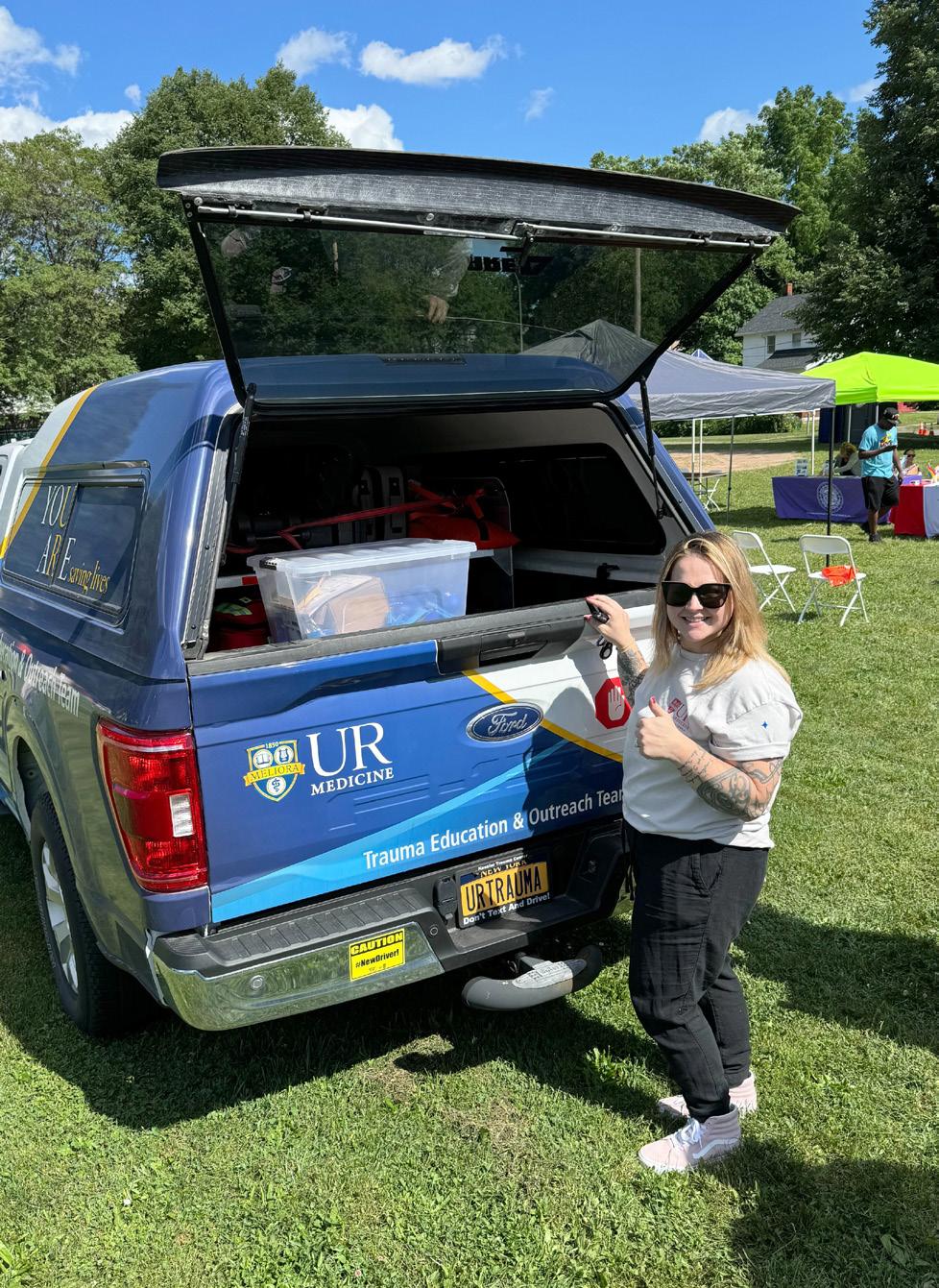
alongside various safety items such as flashing light clips, reflective armbands, and reflective zipper pulls to attendees.
The Kessler Trauma Center has been a Trauma Survivors Network (TSN) site since 2022. The purpose of the TSN is to help trauma centers bring together trauma survivors and their families to connect, support each other and share resources beginning at the time of injury and continuing throughout the recovery process. By recognizing that psychosocial support is as important as physical care, the TSN program works by building a community of advocates who focus on injury
prevention and training health care providers to deliver holistic, high-quality care and provide necessary support aimed at improving patient outcomes. Our center, in partnership with Rochester Spinal Cord Association and our UR Medicine’s Physical Medicine and Rehabilitation colleagues, is proud to host an annual Trauma Survivor’s Network Picnic. This event brings together our trauma survivors, their families, and various members of our hospital staff to reunite, share experiences, and make connections with other trauma survivors within our community.

At the Kessler Trauma Center, our greatest strength is our people. Every day, our staff deliver compassionate care, innovate behind the scenes, and go the extra mile for our patients and community. This year, we are proud to recognize several team members who exemplify our mission and values and learn more about them.
NICHOLAS BEDRIN, M.D. –TRAUMA SURGEON

Why did you choose to work in trauma care, and what continues to drive you?
Trauma care allows me to use all my medical and surgical skills, it allows me to give back to my community as trauma spans all populations. It is exceptionally rewarding as a career; it is challenging in many ways, but seeing patients recover from their acute trauma is the best part of the job.
What is something most people don’t realize about working in a trauma center?
We work everywhere in the hospital. We do spend a lot of time in the Emergency Department and the operating room, but we take care of patients in almost every wing of the building and throughout
various stages of disease and healing.
In what ways do you feel you are making an impact on patients or their families?
The other best part of the job is educating the next generation of trauma surgeons and providers. We have trauma education built into our center from the ground up, and this permeates all the way to the bedside. Care of the injured patient is a team effort, and families often get a large portion of it, so ensuring the entire team is providing high quality care is one of my favorite ways to, hopefully, take a scary, frustrating and unsure time and make it more navigable for patients and families.
DEAN WEST, B.S.N., R.N. –PERIOPERATIVE SERVICE NURSE, GENERAL SURGERY & TRAUMA SURGERY

Why did you choose to work in trauma care, and what continues to drive you?
I work in trauma surgery to help patients in my community
have access to the best care possible. The ability to work with patients at their lowest points and help them return to normalcy is incredibly rewarding.
What’s something most people don’t realize about working in a trauma center?
Most people don’t realize the amount of teamwork and communication that is required to provide excellent trauma care.
In what ways do you feel you’re making an impact on patients or their families?
I’m proud to talk about the impact we have on our patients, their family, and our community. Providing efficient, skilled, and compassionate care really makes the difference.
SARAH GORMAN, R.N., B.S.N., E.M.T. –
INJURY PREVENTION AND OUTREACH
COORDINATOR

Why did you choose to work in trauma care and what continues to drive you?
My interest in trauma care started when I began working in emergency medical services. I am continuously motivated when I see the outcomes of learning in real time—whether it’s in-house, pre-hospital, or within the community.
What’s something most people don’t realize about working in a trauma center?
Many people are not aware of the behind the
scenes work that goes into being certified trauma center. As a Level 1 Trauma Center, we must meet certain requirements to uphold our certification. My role as an Injury Prevention and Outreach Coordinator falls into that category. My work goes beyond the bedside, to educate health professionals and the public about injury prevention.
In what ways do you feel you’re making an impact on patients or their families?
Injury prevention has a multifaceted impact on patients and families, encompassing improved patient wellbeing and enhanced family quality of life. Proactively addressing injury risks— by providing the knowledge and tools to prevent mechanisms of injury—allows individuals and families to minimize the negative consequences associated with traumatic injuries and help provide a sense of safety and security.
DAVID PAUL, M.D.–NEUROSURGEON, TRAUMA PROGRAM LIAISON

Why did you choose to work in trauma care, and what continues to drive you?
My introduction to medicine began with my grandfather, a pastor who regularly visited and prayed with patients in the hospital. Those early experiences shaped my understanding of
the hospital—not as a place defined by sickness or despair, but as a space where healing, both physical and spiritual, was possible. Over time, that vision expanded as I became more curious about the brain and nervous system.
During my neurosurgical residency, I felt a clear calling to neurotrauma, a subspecialty where the practice of medicine intersects with the raw reality of humanity. Unlike many areas of healthcare, trauma doesn’t discriminate. It impacts people across every demographic, cutting through barriers of race, class, and background. What continues to drive me is the opportunity to meet patients in their most vulnerable moments and to ensure that each person is treated with both clinical excellence and human dignity.
What’s something most people don’t realize about working in a trauma center?
People often don’t realize the emotional and logistical complexity involved in trauma care. It’s not just about performing lifesaving surgeries, it’s about rapid decisions under extreme pressure, communicating effectively with colleagues across disciplines, and ensuring every patient has the support they need before, during, and after their surgery.
For many of our patients, the journey doesn’t end after surgery—it’s a marathon, not a sprint. The real work continues long after the excitement of the Emergency Department and operating room fades. Especially in neurotrauma, we don’t get to choose
the “ideal” patient. We care for folks as they are: unhoused, battling addiction, sometimes without any family support to speak of. This adds a whole other layer to what recovery looks like. It truly requires a holistic approach, blending technical excellence with empathy and advocacy.
In what ways do you feel you’re making an impact on patients or their families?
My goal has always been to lead by example, especially in a field where Black representation is still limited. As the Director of Brain and Spine Trauma at the University of Rochester, I take on a significant amount of call, help design care protocols for neurotrauma patients, and am involved in launching a dedicated outpatient clinic for those recovering from traumatic brain injuries. Through this work, I advocate for patients who may otherwise fall through the cracks. I want every patient and family—no matter their background, to know that they are seen, valued, and treated with excellence. I also try to bring compassion into every conversation, recognizing the spiritual and psychological dimensions of healing.
Anything else you’d like others to know about you?
Outside the OR, I’m also the founder of Bold and Gritty, a coffee company that uses storytelling to elevate the narratives of individuals who have overcome significant adversity to achieve greatness in life and positively influence their communities. It started as a way to spotlight resilience and grit during a time of national unrest and evolved
into a brand that uplifts voices often left out of the mainstream. Through this work, I’ve found another avenue to inspire and connect with people, especially those who might not yet see themselves in positions like mine. Whether it’s through surgery or storytelling, my mission is to inspire healing, resilience, and hope.
C.S.T.R., C.A.I.S.S. –LEAD TRAUMA REGISTRAR
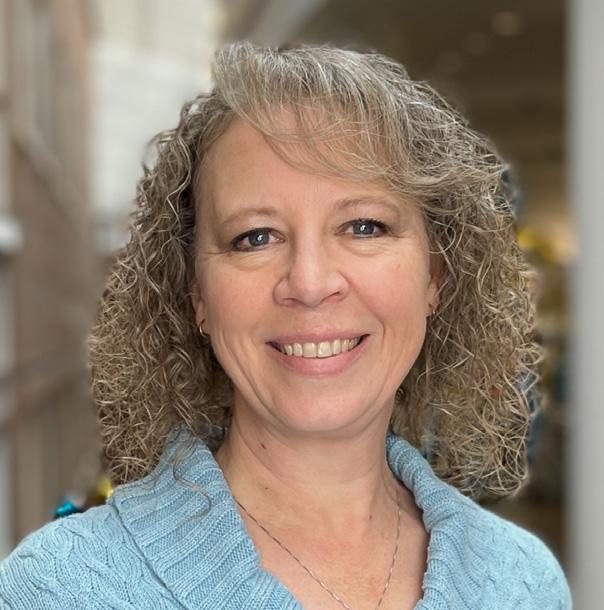
Tell us about your role within the Trauma Program?
Three years ago, in response to the exponential growth of our Trauma Program and patient volume, we established the position of Lead Adult Trauma Registrar—a role I have proudly held since its inception. As the first to occupy this position, I have played a key role in shaping its scope, responsibilities, and long-term value to the trauma service line. I also am actively involved in performance improvement, injury prevention, outreach, research, and supporting the program in any way that is necessary.
What’s something most people don’t realize about working in a trauma center?
ED, ICU, nurses, and providers. In addition to providing expert, life-saving care to trauma patients, trauma centers play a critical role in injury prevention through education and community outreach programs. We also engage in performance improvement (PI) initiatives, which focus on the continuous analysis of clinical outcomes, patient care processes, and systems. Through these combined efforts, a trauma center is not just a place of care, but a catalyst for positive change in the community.
In what ways do you feel you’re making an impact on patients or their families?
While I may not interact directly with families on a day-to-day basis, the integrity of the trauma registry and the continuous improvements driven by this data are key to providing families with the best possible care during their loved one’s time of need.
Anything else you’d like others to know about you?
With a background as an L.P.N. in internal medicine and a degree in Health Care Administration, my role in the Trauma Program has been the perfect fusion of my clinical and administrative interests. This position allows me to seamlessly integrate my passion for critical thinking, medical knowledge, and data management into one dynamic role.
There is more to a trauma center than just the
BECKY CHATT, R.N., M.S. –TRAUMA SERVICE NURSE EDUCATOR
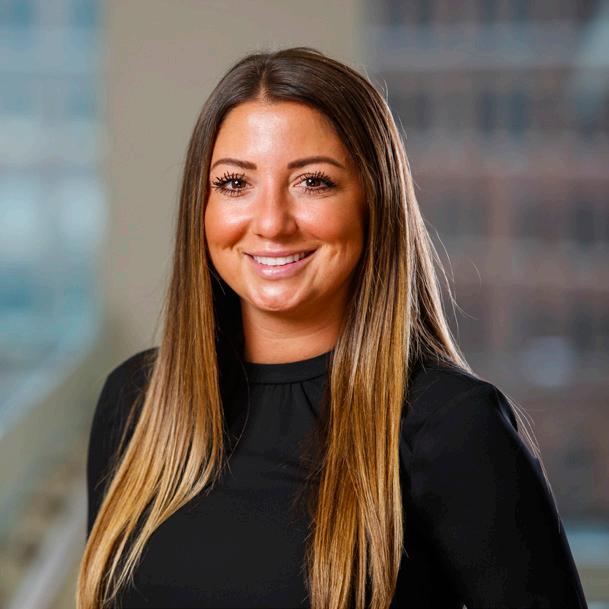
Why did you choose to work in trauma care, and what continues to drive you?
After my grandmother got sick, I decided at the last minute to change my career path from physical therapy to nursing because I saw how much of a positive impact nursing had on her hospital stay. When applying for jobs, I shadowed on various units in the hospital and was immediately drawn to emergency medicine for the fast-paced environment and ability to take care of and learn about many different disease processes.
When I finally started as a new nurse in the Emergency Department, I quickly realized I was drawn to trauma care for many reasons, the biggest one is being able to help patients during one of the most vulnerable moments of their life. I personally work better under pressure, so it is very rewarding to be able to assist in saving a patient’s life in such an intense environment. Likewise, trauma is so unpredictable and dynamic, requiring you to make rapid decisions that can greatly impact the patient, so you need to always be prepared. Trauma care involves diverse injuries and complex scenarios that really test your clinical skills, making it very stimulating. Another aspect that drew me to trauma
care is the multidisciplinary teamwork it requires to take care of this patient population. Being able to make a meaningful impact, the high-intensity environment, complex cases, and teamwork continue to drive me in wanting to provide the best care possible for our trauma patients.
What’s something most people don’t realize about working in a trauma center?
There are a lot of different aspects people don’t realize about working in a trauma center. Since it is such a fast-paced, high-intensity environment, the constant adrenaline and need to make such rapid decisions can be mentally and physically demanding. Witnessing acts of violence—such as shootings, stabbings, child abuse, death—never becomes any easier and can have a long-lasting impact on staff. I think sometimes people forget these cases do not just impact the patients. Staff witnesses family members in distress, which can be completely heartbreaking to observe day after day. Being part of a trauma center does not mean just taking care of the physical injuries, but ensuring we care for the emotional/psychosocial aspect as well and how this can affect them long-term.
Another aspect I don’t think many people realize is that designated trauma centers have a trauma program. This is a structured, multidisciplinary system designed to ensure the highest level of care for injured patients, including but not limited to administration, performance improvement, education and outreach, and coordination with
multidisciplinary services. I think the community is unaware of how much work the Trauma Program does behind the scenes to ensure high-quality consistent care is being delivered to patients to improve survival and outcomes.
In what ways do you feel you’re making an impact on patients or their families?
Even though I am not directly at the bedside as much as I used to be, I still play an important role behind the scenes as the educator that can directly impact patients and their family members. The main focus of my job is ensuring pre-hospital and in-house staff are competent to be taking care of our patients through hands-on skills specific to trauma, courses such as ATLS® or Stop the Bleed®, simulations, and injury prevention initiatives, which all directly impact the care that is being provided to patients and their family members. I am also a coordinator for the Trauma Survivor’s Network that focuses on patients and their family members during their stay and after, providing them with resources and support.
Any other comments you may want to include (especially with both of your interesting backgrounds)!
When I was working in the Emergency Department, I was part of the team that created the “core trauma” group of nurses that work in the critical care bay. This group is important in generating consistency for the various multidisciplinary teams throughout the hospital. The group consists of highly trained,
experienced staff that train the new nurses to ensure the highest quality of care is being delivered. When I was working in the Emergency Department as an Assistant Nurse Manager, I oversaw the group and it was a full-circle moment to be able to work with them in my new role— providing education and performance improvement initiatives.



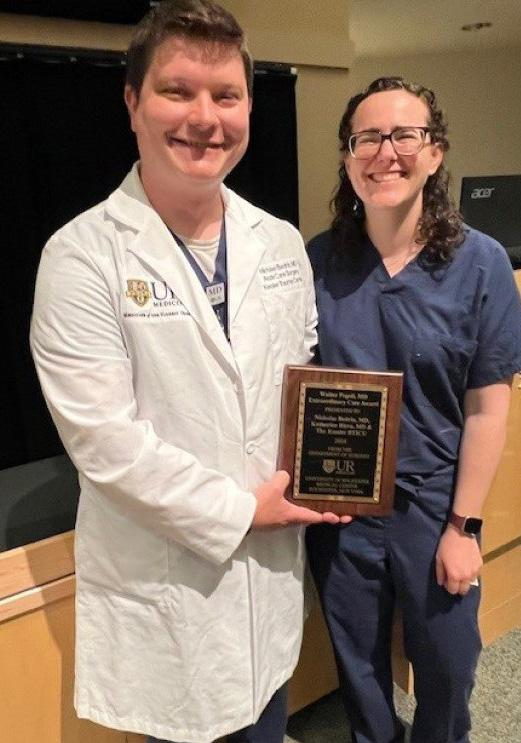
The Kessler Trauma Center at the University of Rochester-Strong Memorial Hospital was reverified as a Level 1 Trauma Center by the American College of Surgeons again in January 2024. These site visits occur every three years and ensure that participating centers maintain the high standards necessary to retain this prestigious designation.
The Kessler Trauma Center has been recognized by the American College of Surgeons TQIP program as a top ten percent performing trauma center in the following categories relative to peer institutions across the United States:
• Adverse hospital events including mortality for all patients (Spring 2021, Fall 2021, Spring 2022, Fall 2022, Spring 2023, Fall 2023, Spring 2024)
• Adverse hospital events including mortality for blunt multisystem patients (Spring 2023, Fall 2023, Spring 2024).
• Adverse hospital events including mortality in patients with severe traumatic brain injury (Fall 2021, Spring 2022, Fall 2022, Spring 2023, Fall 2023, Spring 2024).
Adverse hospital events are defined as any
major patient complication that occurs during hospitalization.
• The 2024 Walter Pegoli, M.D. Extraordinary Care Award was presented to Nicholas Bedrin, M.D., and Katherine Riera, M.D.: “Drs. Riera and Bedrin led the trauma team, which consisted of numerous residents, collaborating physicians, and nurses, through a complex resuscitation with an excellent result. Through their collective efforts, the grateful patient was able to participate in the award ceremony and personally thank the team that saved her life.”
• In 2024, two of our faculty received University of Rochester School of Medicine and Dentistry Medical Student Achievement Awards. Yanjie Qi, M.D., received the Commendation for Third Year Teaching Award and Nicole Stassen, M.D. was chosen for the Gold Medal Award for Excellence.
Mark Gestring, M.D. was honored by the Bureau of Alcohol, Tobacco, Firearms, and Explosives (ATF) and Rochester Police Department (RPD) Violent Crime Task Force, in recognition of his many years of hard work and dedication to the Rochester, New York community.
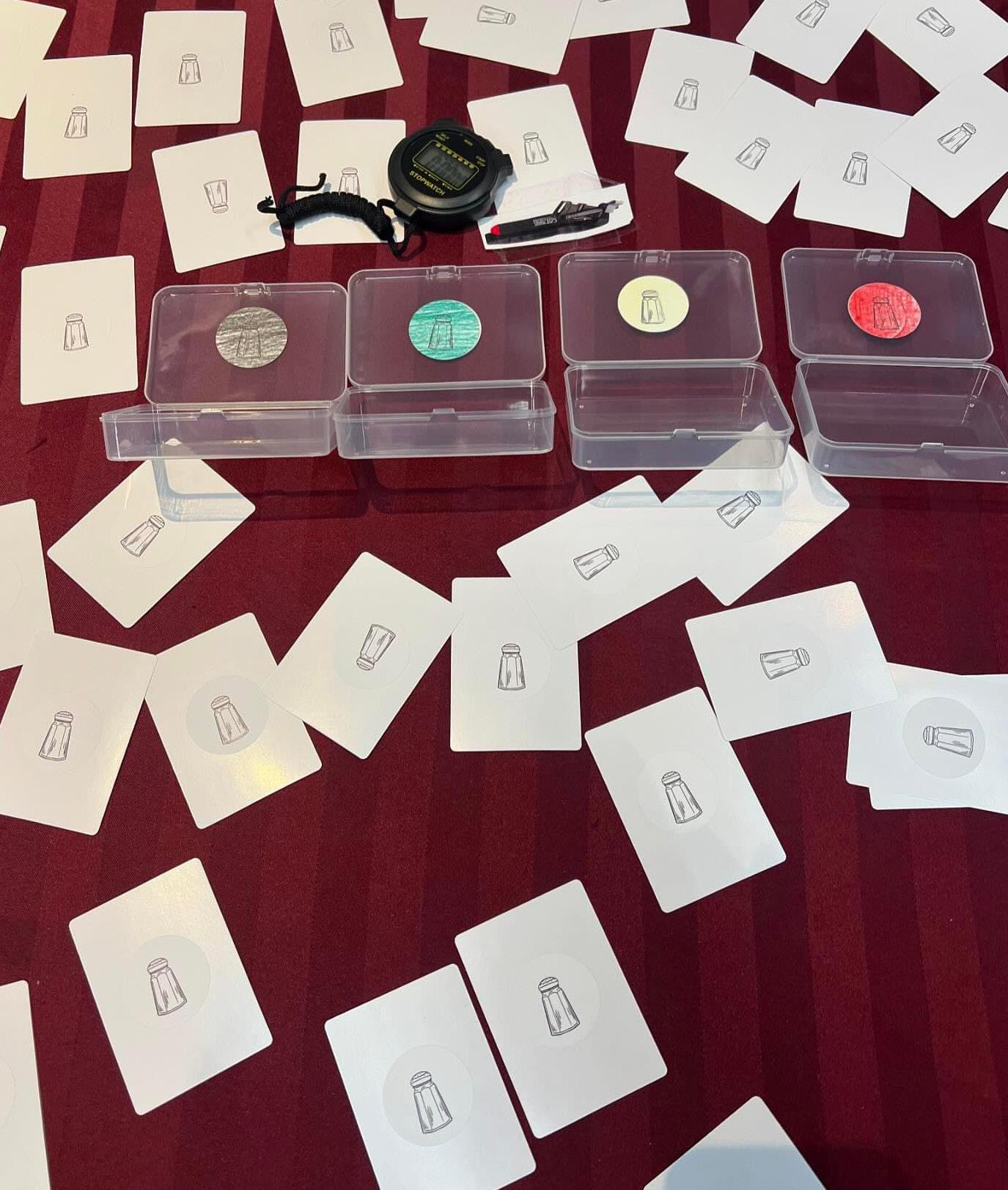

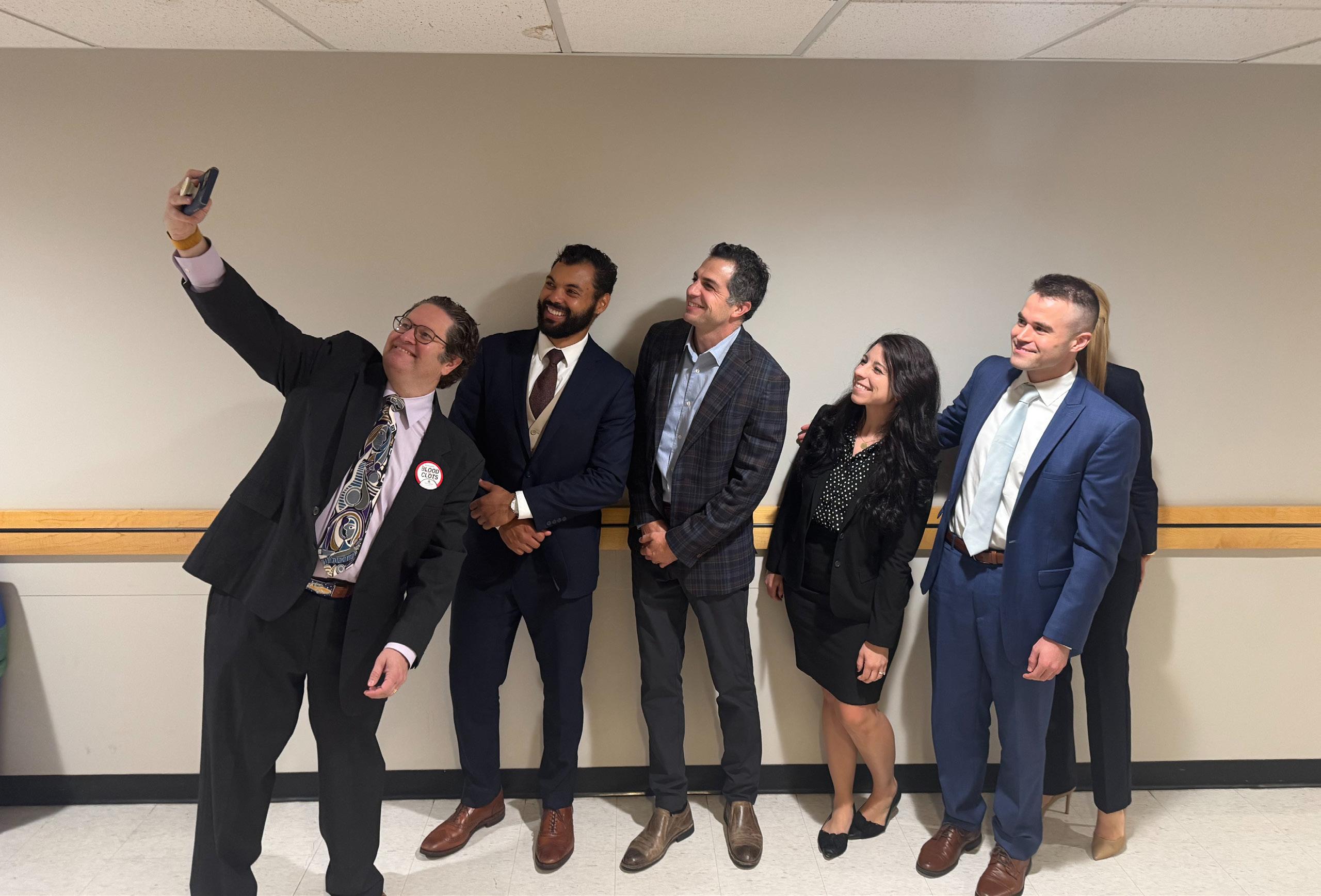
Performance Improvement (PI) is the cornerstone of our Trauma Program, allowing us to ensure that we are providing exceptional, evidence-based care and maintaining the highest standards required for trauma center verification. As such, we continually evaluate and improve upon our already robust PI process. Trauma Program leadership formally meets regularly to review all cases meeting prespecified criteria requiring more in-depth review and to ensure compliance with institutional protocols. This process allows us to proactively identify trends in care that may indicate need for improvements prior to receiving our benchmarking reports from the Trauma Quality Improvement Program. Cases or specific trends requiring additional review are sent to formal morbidity and mortality conference, our monthly multidisciplinary conference, or for broader institutional review, if required. This rigorous process highlights our program and institutional commitment to the PI process and maintaining the highest standards of care.
One of the requirements of a Level 1 Trauma Center is that the Trauma Program participate in the development of the hospital disaster plan, including
creation of a robust response to a “surgical disaster”. A “surgical disaster” is any event in which there is potential need for multiple injured patients to undergo simultaneous urgent or emergent surgeries. To accommodate this, we expanded our disaster preparedness planning to include our perioperative services. A perioperative disaster committee was created to consider all aspects of “surgical preparedness” in conjunction with the larger hospital disaster committee. We held our first annual Perioperative Emergency Preparedness Retreat in collaboration with the Perioperative Leadership Team and URMC Emergency Preparedness Team. This retreat involved a mass casualty incident drill in our main operating room and a thorough debrief. The commitment to strengthening our emergency preparedness was evident by the enthusiastic participation of physicians, nurses, clerical staff, and other ancillary staff from the Emergency Department, Trauma Surgery, Pediatric Trauma Surgery, Anesthesia, Perioperative Services, and Emergency Preparedness. Operating room (OR) communication and triage, creation of multiple available operating rooms over a short period of time, and ability to maintain personnel and equipment to sustain prolonged OR surge is now a primary focus at our institution.
We strive to provide optimal pre-hospital education to the first responder community, to include
EMS, Fire, Police and even the lay public. The desire and need for education on high-acuity, low volume events within our pre-hospital community was evident, particularly on large scale incidents affecting the Greater Rochester area, therefore we used this as an opportunity to create an adapted immersive training to address triage in mass casualty incidents. In collaboration with the Pediatric Trauma Program and Department of Prehospital Medicine, we hosted our first Immersive Disaster Triage Workshop during the New York State Vital Signs Emergency Medical Services Conference. This workshop introduced participants to the Sort, Assess, Life-Saving Interventions, Treatment/ Transport (SALT) mass casualty triage algorithm
utilizing lecture, high fidelity simulations, and a flashcard game created by one of our Pediatric Trauma Program colleagues. We look forward to offering this educational course throughout our trauma region to increase our pre-hospital community knowledge on best practices in the pre-hospital setting during mass casualty events, to improve pre-hospital outcomes, and improve team dynamics from the scene to arrival at the hospital.
The trauma registry is a repository of patient data for all injured patients who meet prespecified inclusion criteria, based on standards from the


National Trauma Data Bank (NTDB) and the New York State Department of Health. Over 200 data points are collected within specialized software for each patient, as well as a significant number of additional fields specific to the needs of our institution and our Trauma Program.
Patient data is abstracted by our specially trained trauma registrars. Our trauma registrars are certified in ICD-10 diagnostic coding and Abbreviated Injury Scale scoring. Our registrar’s abstract data on a combined total of over 3,000 patients per year.
Our trauma registry and registrars are the foundation of our Trauma Program. Registry data guides our performance improvement initiatives and injury prevention activities and is crucial to research efforts across the institution. Furthermore, our data is utilized for our Trauma Quality Improvement Program (TQIP) benchmarking reports.
Transition to New Registry Software – In order to remain compliant with national data standards, we transitioned to a new trauma registry vendor and software. With this new software, our data capture will be more efficient and accurate through the built in AI features, automatic data pulls from the electronic medical record, and logic validators. Furthermore, we will be able to perform more robust performance improvement and research due to expanded report writing capabilities within the registry.
TQIP Poster Presentation – Our Lead Registrar, Margaret Vercruysse, L.P.N., presented a poster titled “Using TQIP Submission Frequency Report to Evaluate the Efficacy of Intervention Instituted for Metrics over the TQIP Threshold” at the Annual TQIP Conference in Denver, Colorado highlighting her hard work in registry performance improvement.

White board in operating room used during perioperative disaster drill
Arrivals to Kessler Trauma CenterAll Injured Patients

Trauma Intensive Care Unit
Admission Volumes

Patient Disposition Following Emergency Department Evaluation

Trauma Team Activations:

Mechanism of Injury:


2024 Transfer Patient Data
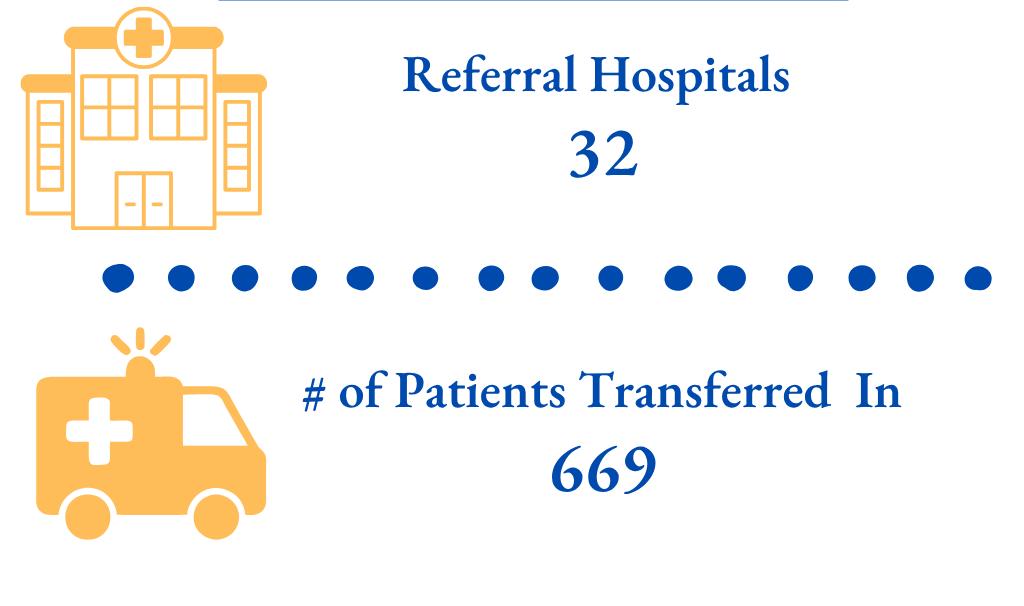
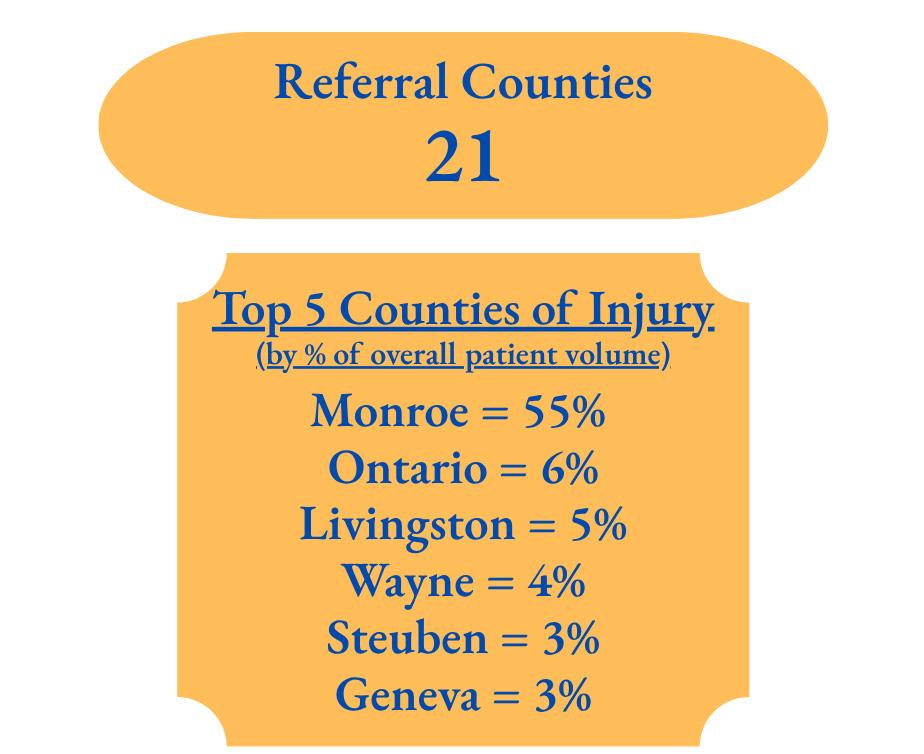

For many years Laurence and Dennis Kessler have dedicated themselves to helping people in their time of greatest need. Through their efforts and those of the managers and employees of the Kessler Group, Inc., The Laurence and Dennis Kessler Regional Trauma Unit in Strong Memorial Hospital’s Emergency Department was dedicated in 1997. In 2003, the Kessler Family, LLC employees joined in fundraising efforts for the first time, initiating a new and generous commitment to name the Burn-Trauma Intensive Care Unit. In 2010, the Kessler Trauma Center was named in honor of the Kessler Family to acknowledge their generosity and extraordinary commitment to injury care in the Finger Lakes region. Successful businessmen, philanthropists, and individuals dedicated to the health of the region, the Kesslers have built an invaluable legacy for the Rochester community and beyond. The charitable works of their employees exemplify their compassionate and generous spirit.
The Kessler Trauma Center relies on the generous support of past patients and their families as well as friends, health professionals, alumni, and community residents. Gifts to the Center have a tremendous impact. Funds are used to educate the next generation of trauma care providers, improve patient care and to support the development of innovative community outreach programs.
The Kessler Trauma Center, as a part of the University of Rochester Medical Center, is a not-for-profit organization and all gifts made to the Center are deductible according to IRS guidelines.
Please contact Kerrie Merz to learn more about how you can help support this important work. (585) 273-2766 Kerrie_Merz@rochester.edu
As the area’s only Level 1 Trauma Center, the team at Strong is proud to provide state-ofthe-art injury care to residents of Rochester, Monroe County and the surrounding region. The new Trauma Resuscitation Unit, a critical part of the expansion project, was designed from the ground up to meet the challenges of modern trauma care. The unit will be significantly larger and will provide immediate access to advanced imaging and treatment modalities.



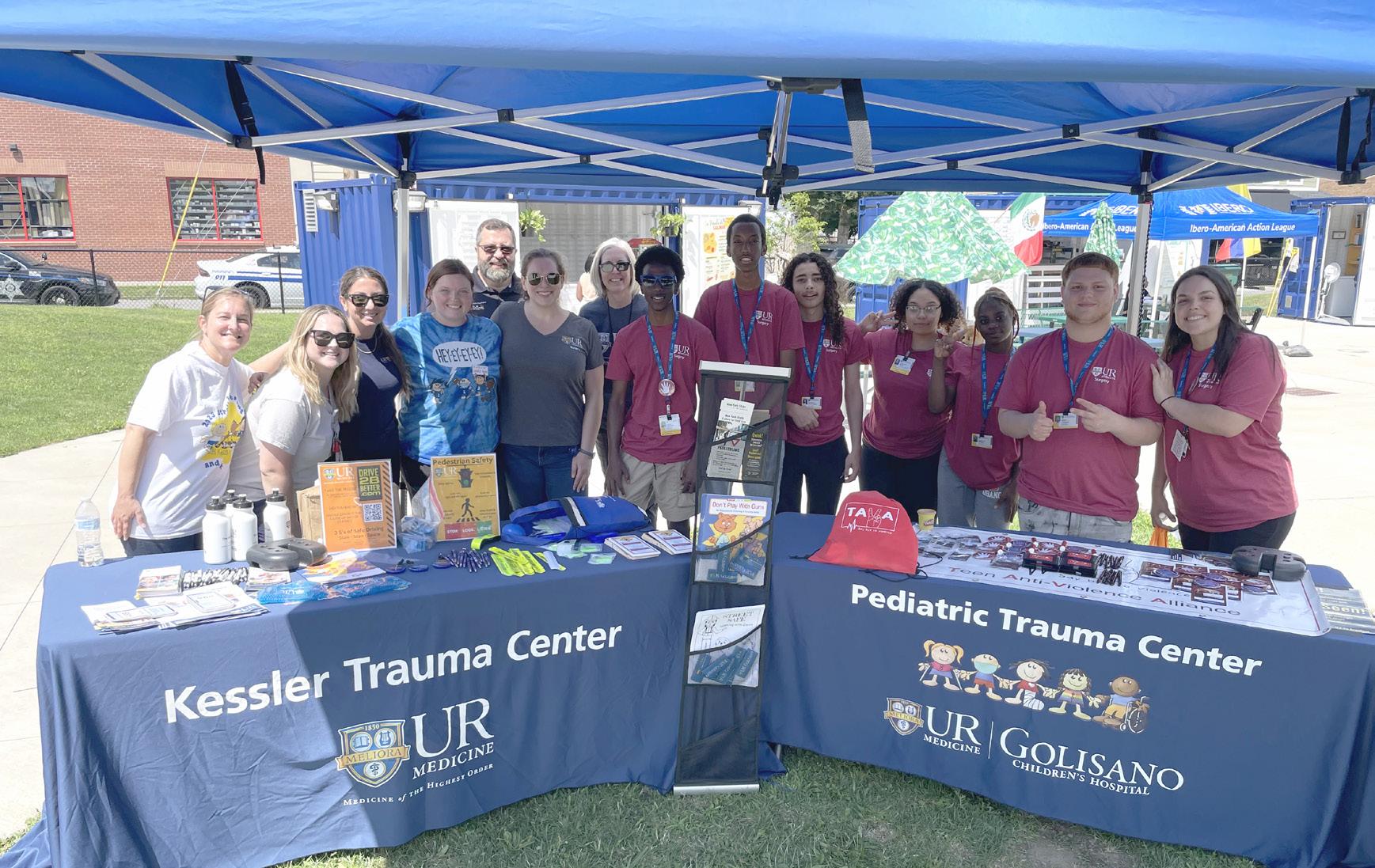


TRAUMA CENTER DEPARTMENT OF SURGERY
